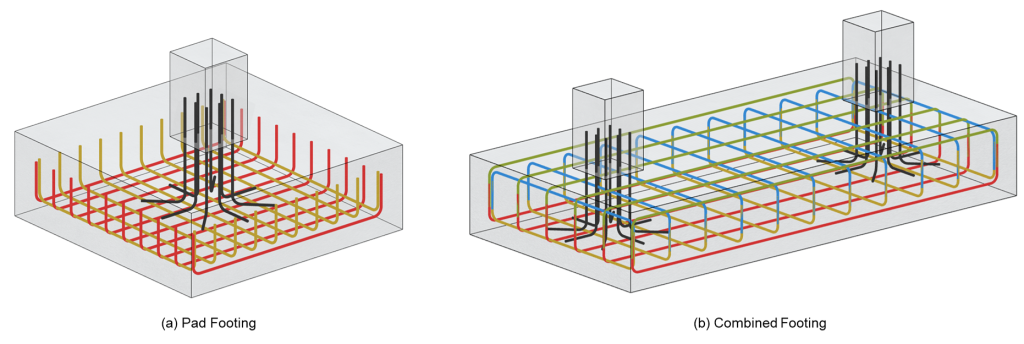İçindekiler
- Ped temellerinde inşaat demiri gelişim uzunluğunu anlamak
- Sıkıştırma Geliştirme Uzunluğu
- Gerilme Geliştirme Uzunluğu
- SkyCiv Temel Tasarım Modülü
Bu belgeler, somut temellerde inşaat demiri gelişim uzunluğunun önemini ve yapısal bütünlüğün sağlanmasındaki rolünü araştırmaktadır.. Tasarım kodu gereksinimleri hakkında bilgi edinebilirsiniz, Gelişim uzunluğunu etkileyen faktörler, ve bunları temel tasarımlarınıza dahil etmek için pratik yaklaşımlar. Artı, SkyCiv Foundation Tasarım Modülünün, projeleriniz için inşaat demiri geliştirme uzunluğunu doğrulama sürecini nasıl basitleştirdiğini keşfedin.
Ped temellerinde inşaat demiri gelişim uzunluğunu anlamak
Beton yapıların stabilitesi ve uzun ömürlülüğü için uygun ankraj ve takviye gereklidir., Özellikle ped temellerinde. Geliştirme uzunluğu, çelik ve beton arasında gerekli bağ mukavemetini elde etmek için gerekli betona gömülü minimum inşaat demiri uzunluğudur.. Geliştirme uzunluğu kontrolü, takviyenin yüklere direnmek için yeterince gömülü olmasını sağlar., Yapısal bütünlüğün korunması ve yere güvenli yük transferinin sağlanması. Geliştirme uzunluğunun doğrulanması, temel tasarımın önemli bir parçasıdır, Statik ve dinamik yükler altında performansı sağlamak ve genel yapı istikrarını korumak.
Farklı Tasarım Standartları, takviye çubuklarının beton içine güvenli bir şekilde sabitlenmesini sağlamak için bu uzunlukların belirlenmesi için özel yönergeler sağlar.. Bu makale, çeşitli tasarım standartlarına göre belirtilen temel geliştirme uzunluğu gereksinimlerine genel bir bakış sunmaktadır., ACI dahil 318-14 (Amerikan Beton Enstitüsü), GİBİ 3600 (Avustralya Standartları), CSA (Kanada Standartları Birliği), ve EN (Eurocode). Her standart tarafından belirtilen farklı yaklaşımları ve kriterleri inceleyerek, Mühendisler bu yönergeleri uygulamada nasıl etkili bir şekilde uygulayacağınızı daha iyi anlayabilir, sağlam ve uyumlu yapısal tasarımlar sağlamak.
Sıkıştırma Geliştirme Uzunluğu
Bir temelin sıkıştırma geliştirme uzunluğu, takviye çubuklarının uygun ankrajını sağlamak için gerekli kalınlığını belirlemede önemli bir faktördür.. Bu uzunluk, yeterli bağ mukavemetini elde etmek ve basınç yükleri altında kaymayı önlemek için çubukların beton içine yeterince gömülmesi ihtiyacına göre hesaplanır.. Doğru geliştirme uzunluğunun dahil edilmesi, mühendislerin takviye için en uygun kalınlığa sahip temelleri tasarlamasına olanak tanır, yapısal stabilite ve dayanıklılığı sağlamak ve genel güvenliği arttırmak.
Amerikan Beton Enstitüsü (ACI 318 Bölüm 25.4.9)
Metrik:
fY = İnşaat demiri verim gücü (MPa, psi)
f’c = Beton mukavemet (MPa, psi)
db = Dübel çubuğu çapı (mm, içinde)
ѱ r = Hapsetme takviye faktörü (Tablo 25.4.9.3)
ƛ = Beton Tip Faktörü (Tablo 25.4.9.3)
Avustralya Standardı (GİBİ 3600 Bölüm 13.1.5)
Temel Geliştirme Uzunluğu:
fBükülme momentleri kesitlerde her yönde hesaplanır = İnşaat demiri verim gücü (MPa)
fc‘ = Beton mukavemet
db = Başlangıç çubuğu çapı (mm)
Kanada Standart Derneği (CSA bölümü 12.3)
fY = İnşaat demiri verim gücü (MPa)
fc‘ = Beton mukavemet
db = Dübel çubuğu çapı (mm)
Eurocode (Bölümde 8.4)
Temel ankraj uzunluğu (8.4.3)
fY = İnşaat demiri verim gücü (MPa)
fBD = Nihai bağ stresi (MPa)
σSD = Çubuğun, demirlemenin ölçüldüğü konumda tasarım stresi (MPa)
ɸ = Dübel çubuğu çapı (mm)
Tasarım Ankraj uzunluğu (8.4.4)
a1, a2, a3, a4 = 1.0 Sıkıştırma için (Tablo 8.2)
Minimum ankraj uzunluğu (8.4.4)
Gerilme Geliştirme Uzunluğu
Gerilim Geliştirme Uzunluğu, bir temelin boyutlarının gerilme kuvvetlerine karşı takviye için yeterli olmasını sağlamanın anahtarıdır.. Bu uzunluk, beton ve inşaat demiri arasında gerekli bağ gücünü elde etmek için hesaplanmıştır, Düzenin boyutunu ve tasarımını doğrudan etkiler. Gerginlik geliştirme uzunluğunun uygun şekilde belirlenmesi, mühendislerin takviyeyi güvenli bir şekilde sabitleyebilen temeller tasarlamasına olanak tanır, yapının gerilme gerilmelerine dayanmasını ve istikrar ve performansı korumasını sağlamak.
Amerikan Beton Enstitüsü (ACI 318 Bölüm 25.4)
Düz çubuklar (Bölüm 25.4.2.3)
Metrik:
Nerede:
ѱt = Döküm konumu faktörü (Tablo 25.4.2.4)
ѱe = Çubuk kaplama faktörü (Tablo 25.4.2.4)
ѱs = Çubuk Boyut Faktörü (Tablo 25.4.2.4)
cb = Minimum çubuk temiz mesafe (mm, içinde)
KTR = Enine takviye endeksi (mm, içinde)
(cb + KTR) / db ≤ 2.5
Standart kanca çubukları (Bölüm 25.4.3.1)
Metrik:
Nerede:
ѱe = Çubuk kaplama faktörü (Tablo 25.4.3.2)
ѱc = Beton kapak faktörü çubuk (Tablo 25.4.3.2)
ѱr = Güçlendirme faktörü sınırlama (Tablo 25.4.3.2)
Avustralya Standardı (GİBİ 3600 Bölüm 13.1.2.2)
Temel Geliştirme Uzunluğu:
k1 = 1.3 daha fazlası ile inşaat demiri için 300 Çubuğun altına mm beton döküm (1.0 aksi takdirde)
k2 = (132 – db)/100
k3 = 1-[0.15(cd – db)/db]
cd = Minimum çubuk temiz mesafe (mm)
Düz çubuk:
Standart kanca veya dişli:
Kanada Standart Derneği (CSA bölümü 12)
Düz çubuklar (Bölüm 12.2.3)
k1 = Bar Konum Faktörü (12.2.4)
k2 = Kaplama faktörü (12.2.4)
k3 = Beton yoğunluk faktörü (12.2.4)
k4 = Çubuk Boyut Faktörü (12.2.4)
Standart kanca çubukları (Bölüm 12.5)
Eurocode (Bölümde 8.4)
Temel ankraj uzunluğu (8.4.3)
a1, a2, a3, a4 = tabloda gösterilen değerler 8.2 gerginlikte çubuklar için
Minimum ankraj uzunluğu (8.4.4)
SkyCiv Tasarım Modülünün Geliştirme Uzunluğunu Nasıl Doğrulduğuna İlgili Ayrıntılı Bir Kılavuz için, Aşağıdaki bağlantılara bakın:
- Amerikan Beton Enstitüsü (ACI 318)
- Avustralya Standardı (GİBİ 3600)
- Kanada Standart Derneği (CSA A23.3)
- Eurocode (İÇİNDE 1992)
SkyCiv Temel Tasarım Modülü

SkyCiv Foundation Tasarım Modülünün son güncellemesi, standart kancalı takviyeleri dahil etme yeteneğini sunarak işlevselliğini geliştirir, Daha kesin ve ayrıntılı geliştirme uzunluğu kontrollerini etkinleştirmek. Bu yeni özellik, kullanıcılara temel çubukların her iki ucundaki takviye detaylarını özelleştirmelerine izin vererek daha fazla esneklik sağlar.. Kullanıcılar artık takviye uçlarını düz çubuklar olarak belirleyebilir, 90-Derece kancalar (çarklar), veya 180 derecelik kancalar, Çeşitli tasarım gereksinimlerine ve standartlarına hitap etmek.

Modül ayrıca, takviyenin detaylandırma kontrollerini incelemeye görsel olarak yardımcı olan güncellenmiş grafiklere sahiptir.. Sütun Dübel veya Başlangıç Çubukları artık 3D grafiklerde görülebilir. Çeşitli sekmenin altındaki yeni eklenen çözücü ayarlarıyla, Kullanıcılar belirli tasarım kontrollerini göz ardı etmek için geçiş yapabilir, geliştirme uzunluğu kontrolleri ve diğer gelişmiş çözme seçenekleri gibi.
SkyCiv’in Temel Tasarım yazılımını denemek ister misiniz?? Ücretsiz aracımız kullanıcıların aşağıdaki işlemleri gerçekleştirmesine olanak tanır: beton temel hesaplamaları herhangi bir indirme veya kurulum gerekmeden!


